GROSS MOTOR FUNCTION MEASURE AND THE OPTIMI PERCENTILE CALCULATOR
Clinicians regularly use outcome measures to monitor changes in the children in their care and help to demonstrate evidence based practice. One of the most common measures used for children with cerebral palsy is the Gross Motor Function Measure (GMFM), an internationally recognised, standardised and validated measure. This evaluative tool provides information about a child’s functional skills at a specific point in time and gives information about abilities relative to other children with cerebral palsy.
The Motor Development Curves combined the GMFM and Gross Motor Function Classification System (GMFCS), enable evaluation of functional skills relative to the average for a child’s age and GMFCS Level. The tabulated reference percentiles*, as graphical data, are available on-line meaning that clinicians can make a more accurate review of a child’s progress. These tables provide information at 0, 3, 6 and 9 months for each year from 2 years to 12 years 0 months with GMFM scores enabling identification of every 5th percentile from 5th to 95th with the addition of the 3rd and 97th percentile.
*Percentiles are most commonly seen in the standard height and weight charts used to monitor growth in childhood. The percentiles referred to here, monitoring functional change, work in exactly the same way.
The Optimi Percentile Calculator has further developed this work by creation of a tool that accurately calculates the percentile, rather than relying on specifying a point on a printed graph. It requires only the child’s date of birth, GMFCS Level, date of assessment and GMFM score to be entered. Data can also be entered for several GMFM assessments of the same child over time. A graph is then produced which can be printed and filed or stored electronically (Please observe local Data Protection rules).
This work was therefore to develop a system extending the use of Reference Percentiles to numerically calculate the percentile and to be able to present the mean percentile change over a course of therapy/intervention so that individual and group results can be easily and accurately determined.
This system also enables easier comparison of clinical outcomes in children with cerebral palsy between physiotherapists, between departments and possibly even between countries. It is recognised that the GMFM is a measure based on therapeutic strategies in use some years ago and today’s practice may be quite different. However, GMFM remains in widespread use and retains value.
Clinicians will naturally wish to see an increase in GMFM score in the children in their care, although recognising from the Motor Development Curves that there may be some plateauing or even some reduction in abilities with increasing age, depending on a child’s GMFCS Level. Caution must be used when interpreting percentile comparisons since the expected within-child variability in percentiles is substantial. Clinicians should also be aware that an increase in GMFM score does not necessarily equate with an increase in percentile! A child may be performing more activities but still falling behind comparable children in same GMFCS Level.
Take a look at these example percentile graphs.
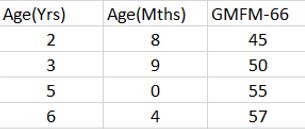
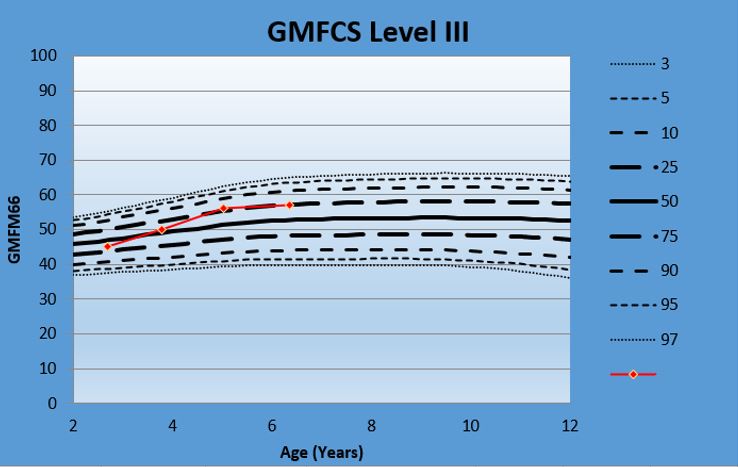




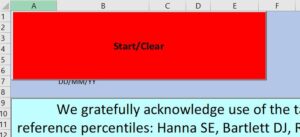
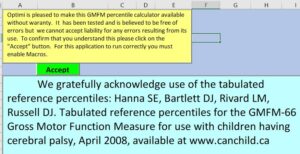
 Entries should only be made in white boxes (any other entries will have unpredictable results). The child’s date of birth (DoB) should be entered into the box that the red arrow points to (The two boxes above may be left empty or you can use you own reference and name entries as you prefer). Note that DoB must be in DD/MM/YY format and the child’s age must be between 2 and 12 years.
Entries should only be made in white boxes (any other entries will have unpredictable results). The child’s date of birth (DoB) should be entered into the box that the red arrow points to (The two boxes above may be left empty or you can use you own reference and name entries as you prefer). Note that DoB must be in DD/MM/YY format and the child’s age must be between 2 and 12 years.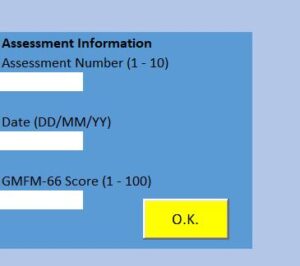 Now data from up to 10 assessments can be entered (please enter then in ascending date order:
Now data from up to 10 assessments can be entered (please enter then in ascending date order: